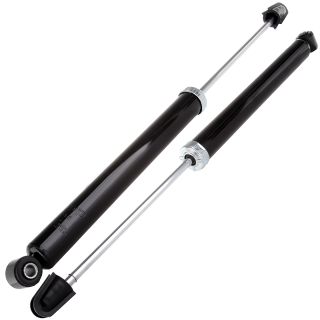The function of the shock absorber is to ensure that the tires of your vehicle are always on the ground. They do this by managing the movement of the suspension and springs.
This keeps your tires in contact with the road at all times, whether it is going straight, turning, overturning a mountain or driving on a bumpy road. All vibrations and shaking from driving on such roads will be absorbed by the springs and shock absorbers of the vehicle, hence the name.
Don't confuse shock absorbers and struts, because they are different. The strut is built into the structure of the suspension system, and the shock absorber connects the two parts of the suspension together. In other words, all the weight of the vehicle is placed on the strut, not the shock absorber.

What is a Shock Absorber?
A shock absorber, usually called a "shock", is a suspension component that is responsible for controlling the up and down movement of the vehicle's wheels.
Although the spring mainly deals with the energy absorbed from the road bumps, if there is no shock absorber, your vehicle will continue to bounce on the spring for a while after encountering the bumps.
The shock absorber absorbs this unwanted spring movement. This process is called damping, and it is essential unless you want to drive with very little control.
Top 6 Bad Shock Absorber Symptoms
One or more shock absorbers will eventually deteriorate and eventually fail to work. When strange symptoms appear, many people have a hard time figuring out which one has gone bad. Here are the six most common signs that may indicate a problem with your shock absorber.
1. Knocking Noise

When passing various bumps, speed bumps or potholes, you hear knocking sounds, which may mean that you have worn out the shock absorber. The noise may be the coil spring actually hitting the car chassis.
The points at both ends of the shock absorber contain rubber bushings. As long as a crack is formed in the rubber bushing, a knocking sound or knocking sound will be produced, which can be heard every time a bump is encountered during driving.
2. Vibrations

There are valves and piston seals inside the shock absorber. If any of them are worn too badly, the flow of fluid will be uncontrolled and it will pass through the piston seal and/or valve.
Once this happens, the steering wheel will vibrate every time you drive through bumps, regardless of the size of the bumps.
3. Fluid Leak

The main body of the shock absorber has a seal to prevent it from leaking. After some time, these seals will begin to leak liquid along the sides of the shock absorber body until it falls to the ground.
If the shock absorber loses too much liquid, it will not work properly.
4. Swerving

If you step on the brake pedal while turning, you may experience turning or diving. When the shock absorber fails, the weight of the car will move in the opposite direction when you turn.
This will cause you to turn and require more work to fix the turn in the direction you want to go.
5. Brakes React Slowly

If you step on the brake pedal and it takes a while for your car to slow down and stop, then your shock absorber may be faulty.
This may be due to the vehicle not tightening the length of the piston rod fast enough. Therefore, the vehicle needs more time to complete this task.
6. Uneven Tire Wear

Since poor shock absorbers can cause your tires to be unevenly placed on the road, your car will start to bounce when driving.
In fact, only certain areas of the tire will touch the road surface, which will cause these areas to wear more than the areas that do not touch the road surface. Therefore, you will have uneven tire wear.
Shock Absorber Replacement Cost
If you find that the shock absorber is damaged, you need to replace it as soon as possible. Since shock absorbers should always be replaced in pairs, it is estimated that a total of about $250 to $580 will be required.
A single shock absorber price ranges from $50 to $140, depending on the make and model of your vehicle, so for this pair of shock absorbers, the part price ranges from $100 to $280.
The labor costs associated with replacing a pair of shock absorbers will be between $150 and $300, depending on the hourly rate of the store or mechanic and the convenience of the particular vehicle.
Although its procedure is not too expensive, please make sure to replace the shock absorber immediately before more serious damage occurs to your vehicle.
Can You Drive With a Faulty Shock Absorber?
Unless the shock absorber fails completely, you can usually drive it in the early stages of wear, but you should replace it (and the one on the other side of the axle) as soon as possible.
However, some of the above symptoms require you to stop driving immediately. Liquid leakage and any symptoms that cause a decrease in driving control should cause you to stop driving until the shock absorber replacement.
Ignoring this may put you and others in immediate danger due to sudden loss of control on the road.













